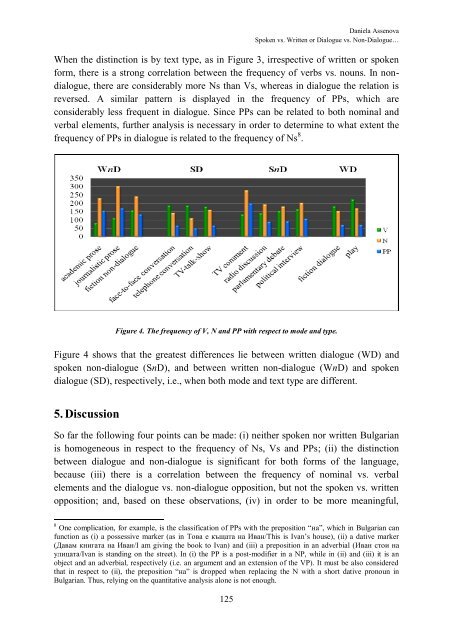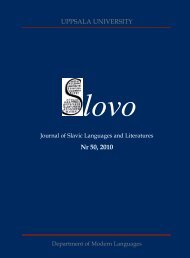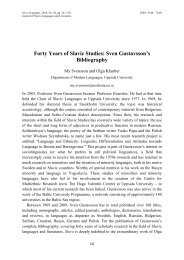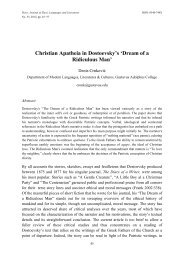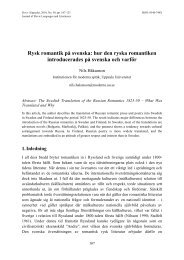UPPSALA UNIVERSITY - Index of - Uppsala universitet
UPPSALA UNIVERSITY - Index of - Uppsala universitet
UPPSALA UNIVERSITY - Index of - Uppsala universitet
- No tags were found...
You also want an ePaper? Increase the reach of your titles
YUMPU automatically turns print PDFs into web optimized ePapers that Google loves.
Daniela AssenovaSpoken vs. Written or Dialogue vs. Non-Dialogue…When the distinction is by text type, as in Figure 3, irrespective <strong>of</strong> written or spokenform, there is a strong correlation between the frequency <strong>of</strong> verbs vs. nouns. In nondialogue,there are considerably more Ns than Vs, whereas in dialogue the relation isreversed. A similar pattern is displayed in the frequency <strong>of</strong> PPs, which areconsiderably less frequent in dialogue. Since PPs can be related to both nominal andverbal elements, further analysis is necessary in order to determine to what extent thefrequency <strong>of</strong> PPs in dialogue is related to the frequency <strong>of</strong> Ns 8 .Figure 4. The frequency <strong>of</strong> V, N and PP with respect to mode and type.Figure 4 shows that the greatest differences lie between written dialogue (WD) andspoken non-dialogue (SnD), and between written non-dialogue (WnD) and spokendialogue (SD), respectively, i.e., when both mode and text type are different.5. DiscussionSo far the following four points can be made: (i) neither spoken nor written Bulgarianis homogeneous in respect to the frequency <strong>of</strong> Ns, Vs and PPs; (ii) the distinctionbetween dialogue and non-dialogue is significant for both forms <strong>of</strong> the language,because (iii) there is a correlation between the frequency <strong>of</strong> nominal vs. verbalelements and the dialogue vs. non-dialogue opposition, but not the spoken vs. writtenopposition; and, based on these observations, (iv) in order to be more meaningful,8 One complication, for example, is the classification <strong>of</strong> PPs with the preposition “на”, which in Bulgarian canfunction as (i) a possessive marker (as in Това е къщата на Иван/This is Ivan‟s house), (ii) a dative marker(Давам книгата на Иван/I am giving the book to Ivan) and (iii) a preposition in an adverbial (Иван стои наулицата/Ivan is standing on the street). In (i) the PP is a post-modifier in a NP, while in (ii) and (iii) it is anobject and an adverbial, respectively (i.e. an argument and an extension <strong>of</strong> the VP). It must be also consideredthat in respect to (ii), the preposition “на” is dropped when replacing the N with a short dative pronoun inBulgarian. Thus, relying on the quantitative analysis alone is not enough.125


